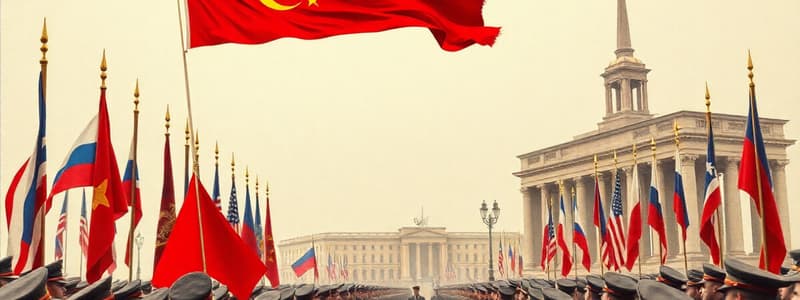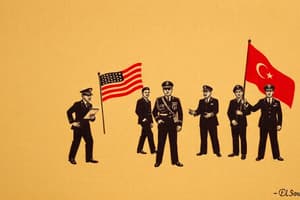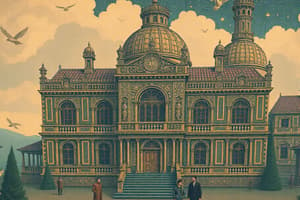Podcast
Questions and Answers
Which of the following was NOT a factor contributing to the weakening of colonial powers after World War II?
Which of the following was NOT a factor contributing to the weakening of colonial powers after World War II?
- The spread of the idea of self-determination
- The economic devastation of World War II
- The growing strength of anti-colonial movements
- The increasing support from communist countries like the Soviet Union (correct)
The United States and the Soviet Union actively supported anti-colonial movements during the Cold War.
The United States and the Soviet Union actively supported anti-colonial movements during the Cold War.
True (A)
What were the three major conferences held by the Allied powers during World War II to plan for the post-war world?
What were the three major conferences held by the Allied powers during World War II to plan for the post-war world?
Tehran Conference, Yalta Conference, Potsdam Conference
The idea that each country should choose its own form of government and leaders is known as ______.
The idea that each country should choose its own form of government and leaders is known as ______.
Match the following leaders with their respective roles:
Match the following leaders with their respective roles:
Which of the following conferences was held in Iran?
Which of the following conferences was held in Iran?
At the Tehran Conference, the Allies agreed on a plan to reconstruct Eastern Europe.
At the Tehran Conference, the Allies agreed on a plan to reconstruct Eastern Europe.
What major disagreement arose at the Yalta Conference?
What major disagreement arose at the Yalta Conference?
The Potsdam Conference was held in ______ in 1945.
The Potsdam Conference was held in ______ in 1945.
Harry Truman was the US president at the Yalta Conference.
Harry Truman was the US president at the Yalta Conference.
Match the following leaders with their respective conferences:
Match the following leaders with their respective conferences:
What was the key outcome of the Potsdam Conference regarding Eastern Europe?
What was the key outcome of the Potsdam Conference regarding Eastern Europe?
Which of the following statements accurately reflects the outcome of the Yalta Conference?
Which of the following statements accurately reflects the outcome of the Yalta Conference?
Which country suffered the least during World War II relative to the others?
Which country suffered the least during World War II relative to the others?
The war resulted in the death of approximately 40 million to 60 million people.
The war resulted in the death of approximately 40 million to 60 million people.
What aid program did the United States implement to assist European countries after World War II?
What aid program did the United States implement to assist European countries after World War II?
The countries most affected by the war included the Soviet Union, Poland, and __________.
The countries most affected by the war included the Soviet Union, Poland, and __________.
What was a significant outcome of the Potsdam Conference related to global power dynamics?
What was a significant outcome of the Potsdam Conference related to global power dynamics?
Western Europe became more influential and powerful in the world after World War II.
Western Europe became more influential and powerful in the world after World War II.
Name one country that had a strong tradition of democracy and rule of law after WWII despite war losses.
Name one country that had a strong tradition of democracy and rule of law after WWII despite war losses.
Match the following countries with their respective population loss during WWII:
Match the following countries with their respective population loss during WWII:
What year did the number of independent nations rise to about 190?
What year did the number of independent nations rise to about 190?
The United States and the Soviet Union were both capitalist countries during the Cold War.
The United States and the Soviet Union were both capitalist countries during the Cold War.
Name the three leaders of the Allies known as the Big Three during World War II.
Name the three leaders of the Allies known as the Big Three during World War II.
After World War II, the desire for independence from colonial rule was linked to a global ideological conflict between _________ and __________.
After World War II, the desire for independence from colonial rule was linked to a global ideological conflict between _________ and __________.
Match the following terms related to the Cold War with their descriptions:
Match the following terms related to the Cold War with their descriptions:
What was a consequence of the Cold War related to independence movements?
What was a consequence of the Cold War related to independence movements?
The Big Three leaders only met once to discuss the post-war world.
The Big Three leaders only met once to discuss the post-war world.
What underlying hopes were revived for colonies after World War I?
What underlying hopes were revived for colonies after World War I?
What two major developments emerged in the late 20th century as a result of the aftermath of the world wars?
What two major developments emerged in the late 20th century as a result of the aftermath of the world wars?
The Korean War was primarily a conflict between European states.
The Korean War was primarily a conflict between European states.
Name one effect of the decolonization movement on newly independent states.
Name one effect of the decolonization movement on newly independent states.
The ______ was formed by Western nations as a pledge of mutual support against the Soviet Union.
The ______ was formed by Western nations as a pledge of mutual support against the Soviet Union.
Match the events with their corresponding years:
Match the events with their corresponding years:
Which of the following movements advocated nonviolence during the Cold War?
Which of the following movements advocated nonviolence during the Cold War?
Armed struggles were uncommon during decolonization efforts.
Armed struggles were uncommon during decolonization efforts.
What were the two superpowers that emerged after World War II?
What were the two superpowers that emerged after World War II?
Which country emerged as the only challenger to the United States in military might and political influence by the end of the 1940s?
Which country emerged as the only challenger to the United States in military might and political influence by the end of the 1940s?
The Cold War involved direct military confrontation between the United States and the Soviet Union.
The Cold War involved direct military confrontation between the United States and the Soviet Union.
What was one of the most important medical advances developed during World War II?
What was one of the most important medical advances developed during World War II?
The informal alliance between the government and large defense contractors is known as the __________.
The informal alliance between the government and large defense contractors is known as the __________.
Match the following terms with their definitions:
Match the following terms with their definitions:
What was a significant consequence of the U.S.-Soviet rivalry during the Cold War?
What was a significant consequence of the U.S.-Soviet rivalry during the Cold War?
Colonialism was significantly undermined following World War II.
Colonialism was significantly undermined following World War II.
What did President Dwight Eisenhower warn against regarding U.S.-Soviet competition?
What did President Dwight Eisenhower warn against regarding U.S.-Soviet competition?
Flashcards
Potsdam Conference
Potsdam Conference
A 1945 meeting of Allied leaders to discuss post-war order, but unresolved issues led to cold war tensions.
Cold War
Cold War
A period of geopolitical tension between the US and Soviet Union after WWII, marked by ideological conflict.
Post-War Devastation
Post-War Devastation
Extensive destruction in Europe and Asia after WWII, leading to significant loss of life and infrastructure.
Population Loss
Population Loss
Signup and view all the flashcards
Marshall Plan
Marshall Plan
Signup and view all the flashcards
U.S. Industrial Strength
U.S. Industrial Strength
Signup and view all the flashcards
Soviet Atomic Bomb
Soviet Atomic Bomb
Signup and view all the flashcards
Western Europe's Advantages
Western Europe's Advantages
Signup and view all the flashcards
Colonization
Colonization
Signup and view all the flashcards
Self-determination
Self-determination
Signup and view all the flashcards
Anti-colonial movements
Anti-colonial movements
Signup and view all the flashcards
Impact of World War II
Impact of World War II
Signup and view all the flashcards
Cold War influence
Cold War influence
Signup and view all the flashcards
Nationalist Movements
Nationalist Movements
Signup and view all the flashcards
Proxy Wars
Proxy Wars
Signup and view all the flashcards
Non-Aligned Movement
Non-Aligned Movement
Signup and view all the flashcards
NATO
NATO
Signup and view all the flashcards
Warsaw Pact
Warsaw Pact
Signup and view all the flashcards
Tiananmen Square Incident
Tiananmen Square Incident
Signup and view all the flashcards
Tehran Conference
Tehran Conference
Signup and view all the flashcards
Focus of the Allies at Tehran
Focus of the Allies at Tehran
Signup and view all the flashcards
Polish territory agreement
Polish territory agreement
Signup and view all the flashcards
Yalta Conference
Yalta Conference
Signup and view all the flashcards
Stalin's demands at Yalta
Stalin's demands at Yalta
Signup and view all the flashcards
Soviet pledge at Yalta
Soviet pledge at Yalta
Signup and view all the flashcards
Truman's demands at Potsdam
Truman's demands at Potsdam
Signup and view all the flashcards
Big Three
Big Three
Signup and view all the flashcards
Ideological struggle
Ideological struggle
Signup and view all the flashcards
Influence in the Cold War
Influence in the Cold War
Signup and view all the flashcards
Post-war world planning
Post-war world planning
Signup and view all the flashcards
Communism in China
Communism in China
Signup and view all the flashcards
Independence movements
Independence movements
Signup and view all the flashcards
Arms Race
Arms Race
Signup and view all the flashcards
Military-Industrial Complex
Military-Industrial Complex
Signup and view all the flashcards
Hydrogen Bomb
Hydrogen Bomb
Signup and view all the flashcards
Penicillin
Penicillin
Signup and view all the flashcards
Technological Advances
Technological Advances
Signup and view all the flashcards
Colonialism Undermining
Colonialism Undermining
Signup and view all the flashcards
U.S.-Soviet Tensions
U.S.-Soviet Tensions
Signup and view all the flashcards
Study Notes
Cold War and Decolonization
- The aftermath of World War II saw the decline of colonial empires and the rise of a tense conflict between capitalist and communist states (the Cold War).
- Nationalist movements in African and Asian colonies intensified after World War II, leading to independence through negotiation or armed struggle.
- Post-colonial states faced population resettlements and challenges to colonial boundaries.
- Newly independent states often promoted economic development and wealth redistribution.
- The Cold War was a power struggle between the US and the USSR, characterized by competing military alliances, nuclear arms races, and proxy wars.
- The Cold War heightened global tensions, but movements like the Non-Aligned Movement advocated non-violence and alternatives to the established order.
- Soviet economic and military stagnation, along with public discontent, led to the collapse of communist governments in Eastern Europe and the end of the Cold War.
Historical Context of Cold War
- The aftermath of World War II led to a global shift in power.
- Colonies sought independence.
- Ideological conflict between capitalist and communist states (US and USSR) intensified.
Key Events and Developments
- 1945: End of World War II. Colonies began their push for independence.
- 1945-1949: Meetings between US, UK, and USSR leaders (Tehran, Yalta, Potsdam). Discussions over postwar world.
- 1945-1949: Growing ideological conflict between US and USSR.
- Rise of Communism in China: China embraced communism, another major player in the global conflict.
- 1949: Formation of NATO.
- 1950s: Korean War.
- 1955: Formation of the Warsaw Pact.
- 1958: China's Great Leap Forward.
- 1961: Construction of the Berlin Wall.
- 1989: Collapse of the Berlin Wall.
- Late 1980s/Early 1990s: Collapse of communist governments in Eastern Europe and the USSR.
Key Figures and Organizations
- Harry Truman: US President during the early Cold War.
- Josef Stalin: Soviet leader during the early Cold War.
- Dwight D. Eisenhower: Another US President who had to deal with the rise of the Soviet threat.
- NATO (North Atlantic Treaty Organization): Military alliance of mostly Western nations.
- Warsaw Pact: Military alliance of mostly Eastern European nations under Stalin's rule.
Studying That Suits You
Use AI to generate personalized quizzes and flashcards to suit your learning preferences.




